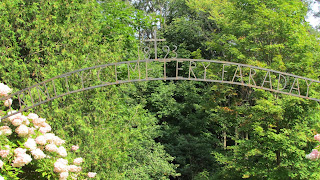Yesterday morning ArchDaily, one of my architecture news feeds, featured a look at
Brutalist Belgrade, seen through the lens of Alexey Kozhenkov. Nothing warm and fuzzy about these strictly functional neighbourhood blocks of undressed concrete. Very 'Eastern Bloc'.
I am rather fond of Brutalist architecture. To develop your own affection, you might visit Shannon Kyles' website OntarioArchitecture. Here's a link to her chapter on Brutalism. The key concepts are emphasis on form and texture, windowless expanses of concrete bearing the forthright marks of the wooden forms from which it emerged after curing.
Brutalism is a child of the 60s, although it emerged in the 1950s during post-war reconstructiom projects in UK. People either love it or hate it. There's that association with utilitarian, low-cost, socialist ideas, which explains its staying power in the former Soviet union. As Shannon notes, it's also popular with universities.

I have a soft spot in my heart for the old National Arts Centre in Ottawa, that "fortress for culture" which raised eyebrows in 1969 when its raw concrete form and texture was being revealed from behind the wooden forms. I recall the outdoor terraces, pebble-surfaced asymmetrical shelves topped with planters, cafes sheltering under the heavy concrete eyebrows. The canal-side main entrance was hidden, a low-ceilinged space reminiscent of a back entrance refuse bin location. Once inside the visitor could get further lost in low-ceilinged hallways and mazes of rough concrete open stairways. Could stir "I'm not worthy" feelings among culture seekers, it was that imposing. Ah, but the performance spaces were wonders. And despite its dourness, I loved it all.
When LOML and I were last in Ottawa, on a cycling trip from a campsite well outside of town, I snapped a couple of photos of the remaining Brutalist presence. But much of what I knew and loved was gone. In a highly celebrated $110 million dollar project, the exterior and interior spaces have been transformed by glass, gold-toned aluminum and pale wood. A glass tower, its surfaces embedded with LEDs for video projections (ermmm) has been added. What the world needs is more flickering screens, writ large.
Another favourite architecture online news source, DeZeen, describes the transformation, inside and out, with lush photos. You'll want to have a look.
The new design opens up views of Parliament Hill and invites light in; it seems more inclusive, bright and inviting, more a gathering place. Less a ticket-holders only sort of spot.
A 2017 article in Capital Modern echoes my resistance to yet another glass building refurb: "..the same imperatives are shaping every type of public building...Make it open and informal. Make it bright. Add cafes. What if, 50 years from now, every public building is a glass pavilion...What if cloistered, dramatic public spaces are again in vogue?" I intend to heed the invitation to explore in person, as soon as I may. Fifty years on, not so likely.

























































